
By Angela Oketch
Monday July 31, 2023

A child is vaccinated against polio at Hagadera Refugee Camp in Dadaad, Garissa County in September 2018. File | Nation Media Group
Kenya has confirmed three polio cases in the Hagadera refugee camp in Garissa County, raising fears of widespread transmission in the facility where more than 90 per cent of new residents are unvaccinated.
Polio is a highly infectious disease that affects children under five years, causing permanent paralysis in one out of 200 infections or death.
In the case of Hagadera camp, the first infections were three children—aged two, two-and-a-half and 19 months—who were born at the camp, already paralysed and the other presenting as asymptomatic.
The two-year-old child, a report said, had received three doses of oral poliovirus vaccine with no travel history while the second one had a travel history from Afmadhow, Lower Juba in southern Somalia and had received the same amounts of dosage.
The two presented with fever and weakness of all limbs.
The third case is of a new arrival from Jamame in Lower Juba-Somalia. They entered Kenya through Dadajabula town and arrived in Dagahaley-Dadaab.
In March 2023, the family moved to Hagadera where they were hosted by a relative.
The family was later identified by the block Community Health Volunteer.
The child had not received any form of immunisation on arrival.
For the first two, they face what doctors refer to as vaccine-derived poliovirus.
Vaccine-derived polio is a type of polio that is derived from vaccination, the oral polio vaccine contains live, weakened polio virus that helps the body to generate immunity towards the virus.
However, when the vaccine is given to children with low immunity, sometimes it mutates and presents in a severe form of a disease.
It affects mainly the population with low immunity and very poor immunisation coverage.
After infection with the virus, it takes an incubation of seven to 10 days.
Up to 90 per cent of those infected are either asymptomatic or experience mild symptoms and the disease usually goes unrecognised. This type of poliovirus is said to affect populations with low immunity and where the immunization coverage is very low.
The World Health Organisation has confirmed through genetic sequencing analysis that the cases are genetically linked to the cVDPV2 circulating in Banadir, Somalia.
New arrivals
The virus, according to the WHO, is common around the world in under-vaccinated communities mostly in the United States and Britain last year.
It is different from the wild poliovirus, which was lastly reported in Kenya in 2013.
According to the World Health Organisation and UNICEF estimates of Kenya’s national immunisation coverage, oral polio vaccine third dose (OPV3) and inactivated poliovirus vaccine first dose (IPV) stand at 91 per cent in 2021.
Mr Reuben Nyaora, who runs the reproductive and community health programme at the International Rescue Committee, said 96 per cent of new arrivals at the Hagadera camp come from Somalia, of which 93 per cent of them are not immunised.
“A majority of our children here have low immunity because of the malnutrition cases at the camp and they are more prone to getting the virus if not vaccinated,” Mr Nyaora said.
He said the camp has seen an influx in the number of people and as a result, the few available resources are stretched to the limit, including water.
“The virus is circulating with research showing that every child found positive for the poliovirus, could spread it to other 200 children within the locality,” said Mr Nyaora.“This is why we are concentrating on this area and doing an intensive screening of the children to identify children who are career who can transmit the virus to children with low immunity and not vaccinated.”